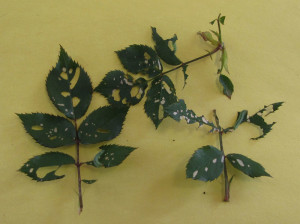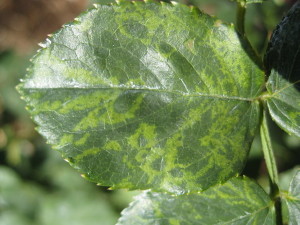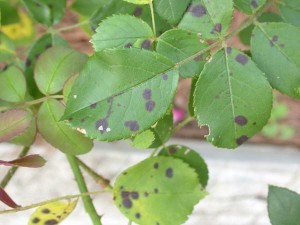
Double Pink Knock Out Rose. Photo courtesy Star Roses
Questions about sick roses continue to fill my inbox and the aisles of garden centers.
Many roses, including the tough-as-nails Knock Outs, did not rebound after our brutal winter. Several of those that did make it through don’t look great.
There’s some thinking that the roots of the plants were damaged by the severe season. They are no longer able to support adequately the top growth, rendering the plants weak and susceptible to insects and diseases.
Cutting the roses back hard – close to the ground – is what we did in spring, but if the plants still are not thriving, consider cutting back again. This reduces the top growth and allows the roots to heal and grow. Fertilizing isn’t necessary, but a good dose of compost around the base of the plant will help.
In the first of a two-parts, here are some common problems we’re seeing:

Rose slug damage on leaves. Photo courtesy Purdue Plant and Pest Diagnostic Lab
Rose slugs. These are the larvae of the rose sawfly. They are a pale green and are usually present in spring and as they dine, they give roses a stained-glass look.
Pear slugs. The damage from these larvae is similar to rose slugs, but appears in summer.
These insects can defoliate roses and give the plant a burned look. Be vigilant about inspecting the undersides of leaves. Remove any larvae or use a strong spray from a hose to knock them off.

Rose mosaic virus leaves tracks in the leaves, eventually turning them yellow from a lack of chlorophyll. Photo courtesy Kansas State University Extension
Rose mosaic. This virus can be spread by insects as they munch and move among the plants. We can spread it, too, with tools that are not cleaned with a 10 percent bleach solution after each use on a sick plant. The disease stunts the growth of roses and causes mottled leaves, which lose their green becoming chlorotic.
Once a rose is infected, you can remove affected branches, but the disease remains in the plant. Eventually, the rose will be weakened and likely will die. Consider removing and destroying affected plants to keep the disease from spreading to healthy roses.

Black spot is the most common disease on roses. Eventually, it can weaken and kill the plant. Photo courtesy Purdue Plant and Pest Diagnostic Lab
Leaf spots. Roses can be affected by two different leaf spots: black spot and spot anthracnose. Black spot, which appear on the top of the leaf, is probably the most common disease on roses. Eventually, the leaves turn yellow and drop. This disease weakens the plant.

Anthracnose is an opportunistic disease that may show up in hot weather.
Photo courtesy Purdue Plant and Pest Diagnostic Lab
Anthracnose spots may show up in really hot weather. The spots are fuzzy. Leaves turn yellow and drop off.
Make sure that any pesticide you select is labeled for the problem you have.
Next week, we’ll look at a few other common rose problems.